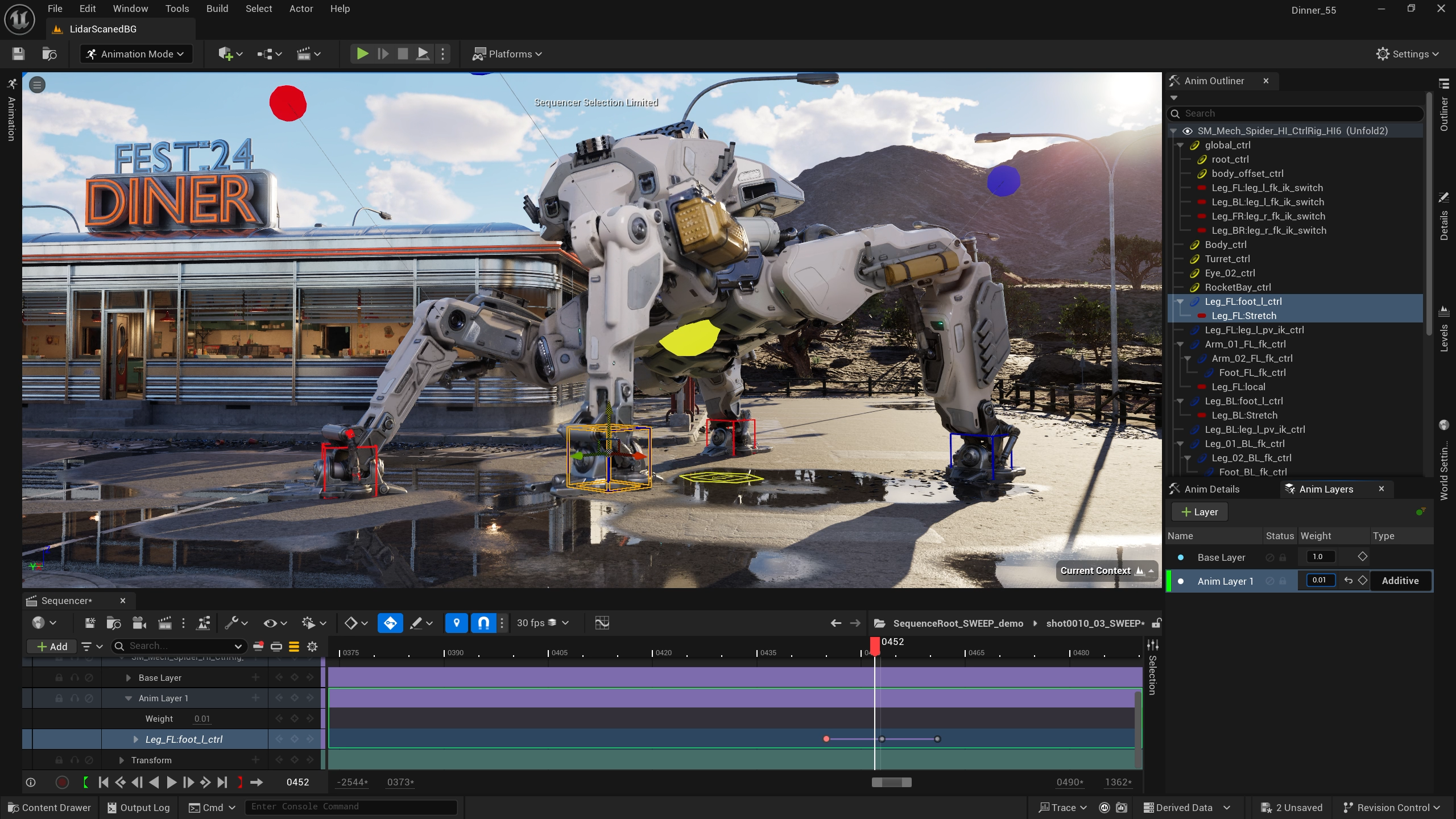Unreal Engine vs Unity: which is right for you?
The two most popular and powerful real-time video game and 3D development platforms compared.

Unreal Engine vs Unity is a battle of two of the best game engines – and certainly the most popular. Together, Epic Games' Unreal Engine and Unity Technologies' self-named platform were responsible for 79% of the games released on Steam in 2024 and 57% of units sold (the difference between the figures is because of the number of big-selling AAA studios who still use their own engines).
Unity is still the most popular of the two in terms of use, accounting for just over half of all games on Steams, but Unreal Engine has overtaken it in terms of sales. That's indicative of a preference for Epic's platform among bigger-selling games, often with the photorealistic 3D graphics that Unreal Engine 5 is known for.
But which game engine is right for you? That will depend on your experience, the type of game you want to make and your plans for the future. In the guide below, I'll compare Unity vs Unreal Engine on various criteria based on the conversations we've had with many game developers in interviews for the site. Hopefully, this might help you make your decision (if you've already used either program, please do share your own experience in the comments section at the bottom).
Whichever program you choose, you're likely to also want one of the best laptops for game development.
Unreal Engine vs Unity: at a glance
| Row 0 - Cell 0 | Unreal Engine | Unity |
Developer | Epic Games | Unity Technologies |
Programming language | C++ | C# |
Visual scripting? | Yes: Blueprint | Via Bolt plugin |
Source code | Source available | Access available with Enterprise Plan |
Learning curve | Steep | More beginner-friendly |
Pricing | Free with 5% royalty after $1m in sales | Free personal plan for revenue/funding under $200,000. Pro subscription $2,200 per seat. Custom Enterprise Plans |
Recommended use | Complex games with 3D realism built to perform on high-end consoles and PCs | 2D and stylised 3D games optimised for a range of platforms, including mobile |
Example games | Fortnite, Gears of War, Black Myth: Wukong, Hellblade II, Tekken 8 | Monument Valley, Hollow Night, Hearthstone, Among Us, Pokémon Go, Survival Kids |
Unreal Engine vs Unity: tools and flexibility

Launched in 1998, Unreal Engine was initially aimed at big AAA game studios (see our main what is Unreal Engine? explainer for more on the history of the engine). Such studios have put their trust in the platform for its capacity to support the development of complex games with incredible fidelity, and UE has become mainly associated with the realistic 3D graphics seen in the likes of The Witcher 3, Final Fantasy and Fortnite.
Standout tools include Nanite and Lumen for detailed virtualised geometry and dynamic global illumination in real time. These help developers create realistic worlds that are highly scalable without compromising performance. Epic has also developed the MetaHuman Creator for the creation of high-fidelity, digital human characters.

Unity emerged in 2005 with the complete opposite aim. It was developed for small indie studios, focusing on flexibility and easy export for various formats, including mobile. It revolutionised the industry and was used for hit games such as Hollow Knight and Among Us. See our piece on What is Unity? And our Unity 6 review
Daily design news, reviews, how-tos and more, as picked by the editors.
However, the introduction of Unreal Engine 5 and Unity 6 have led to more overlap in the uses and possibilities of the two platforms in recent years despite their evolution in slightly different directions.
Unity 6 added the High-definition Render Pipeline in addition to the platform's Universal Render Pipeline to compete with Unreal Engine 5 when it comes to 3D realism. It supports ray tracing for truer reflections and translucency and allows physically accurate light behaviour like UE5's Lumen if a little less performant.
Today, both Unreal Engine and Unity can be used for a wide variety of games. Unity's focus on optimisation still makes it the choice of many devs for games that need to run well on mobile and other devices with limited power, including phones with VR and AR. Its optimisation pipeline is relatively easy to personalise, allowing developers to choose what elements are non-essential to remove for better performance.
Unreal Engine can also be used to create mobile games, but it was designed for high-end games that make the most of the hardware capabilities of latest-generation consoles and PC GPUs.
Unity is also strong for VR and AR applications, and it has a powerful capacity for advanced multiplayer games as Netcode for entities can support hundreds of players.

Both platforms are now widely used outside of game development for making animations, movie VFX, advertising, digital twins and 3D visualisation, but Unreal Engine has become the more popular of the two in these areas, and it's a lot stronger natively for animation.
UE makes it easier to animate high-quality characters using control rigs, and you can transfer animations across characters, while motion matching automatically selects the best animation for seamless animations. Unity did rework its animation system for Unity 6.1 but requires third-party assets for some tasks.
Unreal Engine vs Unity: example games

Unity has been used for many, many games. A few well-known examples include Pokémon Go, Hollow Knight, Cuphead. Fall Guys, and Ori and the Blind Forest. For a long time, it was the favoured engine for many indie developers.
The German indie studio Slow Bros told us that they chose Unity for their unique stopmotion game Harold Halibut because it was accessible and could easily be expanded thanks to the huge community and wide range of third-party plugins.
We also spoke to the former illustrator Gareth Damian Martin about how he made Citizen Sleeper 2 in Unity with no code by using the PlayMaker visual-scripting tool for Unity, which he says opened up game development for him, allowing him to craft a prototype in just a couple of weeks.
Another very artistically creative game made in Unity is Asterism. Solo dev Claire Moorwood told us about how she used the platform to prototype every element with grayboxing to nail the pacing and mechanics before going through all the work of actually making the objects for the game.
As for Unreal Engine, the platform was obviously used in Epic Games' own Fortnite. And it's increasingly being used by AAA studios in place of proprietary engines for complex games that require cutting-edge 3D realism. Unreal Engine 5 was used for the Silent Hill 2 remake and the new Metal Gear Solid Delta: Snake Eater.
We spoke to Sandfall Interactive co-founder Tom Guillermin about how Unreal's Metahuman made character creation easier in Clair Obscur: Expedition 33. And Ninja Theory’s VFX director Mark Slater-Tunstill and environment art director Dan Attwell told us about using Unreal Engine 5 achieve “cinematic realism” in Senua's Saga: Hellblade II 2.
See our pick of the best Unreal Engine 5 games and the best Unreal Engine 5 remakes for more examples of games made with Unreal Engine.
Unreal Engine vs Unity: usability and learning curve

Unreal Engine has a reputation for being somewhat overwhelming due to its steep learning curve. Unity is generally considered to be more intuitive and an easier experience of beginners to dip into, with a clear interface and system of hierachy that allows scenes to managed easily.
Since Unity was initially aimed at small indie developers, its focus from the start has been on accessibility. It has preconfigured components that can allow the creation of fast prototypes, while extensive documentation that makes it easier to find the answers you need. There's also still a wider community for Unity, which again can help if you're looking for tips and advice.
In contrast, Unreal Engine 5 can be daunting due to its more technical focus. There are so many buttons to do so many things, and documentation can sometimes be a little lacking.
It does have the native visual scripting language Blueprint, which allows the creation of complex mechanics without writing code. But for more advanced systems and optimisation, code becomes necessary, and many people find Unreal's c++ harder and less transferable to other programs than the relatively straightforward C# used in Unity. And while Unity doesn't have native visual scripting like Blueprint in UE, it does have the plugin Bolt, which does something similar.
Overall, Unity wins in terms of ease of use, but Unreal does make somethings easier, including post-production, and some argue that Unreal Engine drills beginners on better design patterns while Unity's more freeform nature makes it harder to learn the difference between good and bad decisions.
See our roundup of Unreal Engine 5 tutorials if you do decide to take the plunge with Epic's platform.
| Row 0 - Cell 0 | Unreal Engine 5.6 | Unity 6 |
Windows | Quad-core Intel or AMD, 2.5 GHz or faster, 32GB RAM, DX11 or 12 GPU, 8GB VRAM. | X64 architecture with SSE2 instruction set support, Arm64, 8GB RAM, DX10, 11 or 12 GPU or Vulkan-capable GPUs. |
Mac | Apple M1 or M2 depending on rendering features, 32GB RAM, Metal 1.2-compatible graphics card. | X64 architecture with SSE2 instruction set support or Apple M1 or above, Metal-capable Intel or AMD GPU. |
Linux | Quad-core Intel or AMD, 2.5 GHz or faster, 32GB RAM, GeForce 2080 or better, 8GB VRAM or more. | X64 architecture with SSE2 instruction set support, OpenGL 3.2+ or Vulkan-capable GPU. |
Unity can be less demanding in terms of hardware requirements, making it more feasible to use for game development if you don't have a powerful computer. Unreal Engine can demand more RAM and higher-end GPU, and games developed on Unreal Engine also tend to require higher specs to run depending on their features. They also tend to have larger file sizes, which can be a downside if you're aiming at the mobile market.
Unreal Engine vs Unity: price
Epic Games initially aimed Unreal Engine at AAA studios via a licence system, but it made a radical change in 2015 with Unreal Engine 4, opening access to the platform by adopting a royalty model. It now charges a 5% royalty but only when sales cross the US$1 million mark, effectively democratising access for many small indie game developers as well as filmmakers and archviz artists.
Unity has a free plan for those who made under US$100,000 in revenue in the past 12 months, but everyone else has to pay a per-seat subscription for a licence. There is a 30-day free trial for those who want to test the platform.
In 2023, Unity controversially changed its pricing model announcing that it would charge developers for each installation of a game. It finally scrapped the decision following an outcry among developers, but the incident caused a crisis of confidence in the engine and led some indie studios to start looking at alternatives, including Unreal and the free, open-source Godot.
Fab Store vs Unity Marketplace
Both Unity and Unreal Engine have their respective marketplaces. Epic Games' Fab is an integral solution that combines the former Unreal Engine Marketplace, Sketchfab Store, Quixel and ArtStation Marketplace in one place. It has thousands of assets for a wide range of uses (also see our guide to the best places to get game assets). The Unity Marketplace is also very large but doesn't have as wide a range of assets or the convenience of Fab.
Unreal Engine vs Unity: job opportunities
Another factor that may influence your choice between Unity vs Unreal Engine is the job market. Since Unity is still used more than Unreal Engine, there have been more job offers seeking developers with knowledge of Unity than UE5. But that may be starting to change as more big studios move to Unreal Engine.
The choice may also depend on the type of game and developer you want to work for. Unity dominates for mobile games, but Unreal for 3D games.
Unreal Engine vs Unity: conclusion
Ultimately, the choice of Unity vs Unreal Engine depends on what's important for your game. If you want to keep up with the latest AAA titles in terms of graphics, Unreal Engine 5 is probably the way to go.
It is more complicated to learn at the beginning, but it's better for impressive photorealistic, high-fidelity graphics and worldbuilding, supported by powerful tools like Nanite and Lumen.
If you don't care so much about high-end graphics, prefer regular coding and need to be able to work in 2D quickly and easily, Unity is a more intuitive and user-friendly option that's less demanding on your computer.
I'd say Unity is still ideal for small indie developers, mobile games and smaller projects due to its flexibility and more user-friendly interface. Its robust 2D tools allow rapid prototyping, especially for platforms like mobile and web, and they make it ideal for adding modability to games. It's also a good choice for beginners who just want to try things out and improve their coding skills.

Joe is a regular freelance journalist and editor at Creative Bloq. He writes news, features and buying guides and keeps track of the best equipment and software for creatives, from video editing programs to monitors and accessories. A veteran news writer and photographer, he now works as a project manager at the London and Buenos Aires-based design, production and branding agency Hermana Creatives. There he manages a team of designers, photographers and video editors who specialise in producing visual content and design assets for the hospitality sector. He also dances Argentine tango.
You must confirm your public display name before commenting
Please logout and then login again, you will then be prompted to enter your display name.
